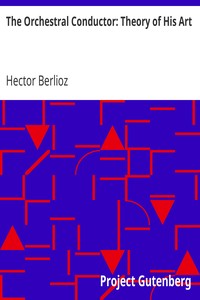The Orchestral Conductor: Theory of His Art by Hector Berlioz
"The Orchestral Conductor: Theory of His Art" by Hector Berlioz is a comprehensive treatise on the intricacies and responsibilities of orchestral conducting, written in the late 19th century. This book functions as a scientific publication that explores the technical and artistic demands placed on a conductor. It delves into the conductor's role as a pivotal figure in interpreting and realizing a composer’s vision, emphasizing the importance of skill, knowledge, and emotional connection
in leading an orchestra. In this work, Berlioz outlines the essential qualities and duties of an orchestral conductor, arguing that the conductor significantly impacts the execution and overall interpretation of musical works. He elaborates on the mechanics of conducting, including beating time accurately and managing various conducting styles depending on the tempo and mood of the piece. Berlioz underscores the importance of clear communication with musicians and the necessity for conductors to be well-versed in the compositions they lead, as well as the characteristics of the instruments in their charge. Ultimately, he critiques common flaws among conductors and orchestras, advocating for more diligent study and rehearsal practices to convey the true essence of the music being performed. (This is an automatically generated summary.)
Read or download for free
| How to read | Url | Size | |||
|---|---|---|---|---|---|
| Read now! | https://www.gutenberg.org/ebooks/27646.html.images | 101 kB | |||
| EPUB3 (E-readers incl. Send-to-Kindle) | https://www.gutenberg.org/ebooks/27646.epub3.images | 449 kB | |||
| EPUB (older E-readers) | https://www.gutenberg.org/ebooks/27646.epub.images | 450 kB | |||
| EPUB (no images, older E-readers) | https://www.gutenberg.org/ebooks/27646.epub.noimages | 94 kB | |||
| Kindle | https://www.gutenberg.org/ebooks/27646.kf8.images | 882 kB | |||
| older Kindles | https://www.gutenberg.org/ebooks/27646.kindle.images | 869 kB | |||
| Plain Text UTF-8 | https://www.gutenberg.org/ebooks/27646.txt.utf-8 | 85 kB | |||
| Download HTML (zip) | https://www.gutenberg.org/cache/epub/27646/pg27646-h.zip | 421 kB | |||
| There may be more files related to this item. | |||||
Similar Books
About this eBook
| Author | Berlioz, Hector, 1803-1869 |
|---|---|
| LoC No. | 03000560 |
| Title | The Orchestral Conductor: Theory of His Art |
| Credits |
Produced by David Newman, Jana Srna and the Online Distributed Proofreading Team at www.pgdp.net |
| Reading Level | Reading ease score: 46.1 (College-level). Difficult to read. |
| Language | English |
| LoC Class | MT: Music: Musical instruction and study, Composition |
| Subject | Conducting |
| Category | Text |
| EBook-No. | 27646 |
| Release Date | Dec 28, 2008 |
| Most Recently Updated | Jan 4, 2021 |
| Copyright Status | Public domain in the USA. |
| Downloads | 362 downloads in the last 30 days. |
| Project Gutenberg eBooks are always free! | |

